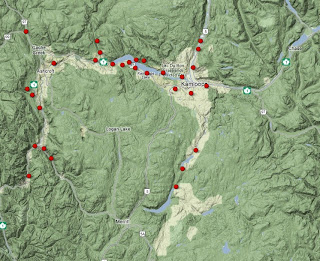The Unintended
Selection Pressures We Exert
Ryan
M.E., Johnson J.R., Fitzpatrick B.M., Lowenstine L.J., Picco A.M., Shaffer H.B.
2012. Lethal Effects of Water Quality on Threatened California Salamanders but
Not on Co-Occurring Hybrid Salamanders. Conservation
Biology. 27(1):95-102
Fitzpatrick, B.M. and H.B. Shaffer. 2007. Introduction
history and habitat variation explain the landscape genetics of hybrid tiger
salamanders. Ecological Applications 17(2):598–608.
We all
understand that as humans we are constantly exerting selection pressures on
many different animals and plants. Because of our over population and consumption,
our controlling nature, and our misuse of land we often drive many species to
extinction, unintentionally create hybrids, and introduce invasive species. In
this paper, the authors struck my interest by discovering a selection pressure
that we exert that was not really known to occur. Before explaining the paper,
I’ll give you a brief history on the topic.
There
are a few different types of tiger salamanders that live across Canada and the
USA. The current situation in California in particular is a terrifying one.
Since the introduction of Barred Tiger Salamanders (Ambystoma tigrinum mavortium) 50 years ago, the native California
Tiger Salamanders (Ambystoma
californiense) have been in trouble (Fitzpatrick and Shaffer 2007). Not
only do the invasive species out-compete the native one, but when interbreeding
occurs the hybrid out-compete both parent species.
 |
| A is the California Tiger Salamander, B is the Barred Tiger Salamander, and C is the hybrid. Photo Source: http://www.ispyanimals.com/2012/01/hybrids-good-bad-and-really-ugly.html |
This
paper initially was looking at the effects of habitat alterations on the native
California tiger salamanders and the hybrid salamander (California and Barred
tiger salamander offspring). They did a series of tests to see if recruitment
of native or hybrid salamander differed when the concentrations of hybrid to
native salamanders were altered, and if these differences were affected by the
pond type (i.e. seasonal or perennial). During these tests, which lasted about
6 weeks, a major die-off of the larva occurred in 4 out of 6 ponds. This was an
unexpected discovery, and the authors were intrigued by it. During these die
offs they found that all of the native salamander larva died, but only 56% of
the hybrid larva died. This is a great example of hybrid vigour, and shows that
the hybrids are more fit. It wasn’t just the salamanders that were affected by
these die-offs either, all the invertebrates in the ponds also died, and a
significant increase in algae and cyanobacteria production was seen. The
authors then looked into the use of pesticides around each of the ponds to see
if they could have caused the major die-offs. They found recent use of the pesticides near
the ponds but they could not directly link the die-offs seen during the
experiment to the use of these pesticides. This could be an example of another
way in which we are exerting selection pressures on these native salamanders.
As if they didn’t have enough to deal with.
Another
reason this paper stuck out while browsing the Conservation Biology Journal
articles, is because last year during Animal Behaviour when we had to write a
proposal for a project, I wanted to look into the effects of pesticides and
hormones in water on the frequencies of cannibalistic and normal morphs of the
blotched tiger salamanders in BC. This gives an indication that water quality
does directly affect these animals, and further studies should be done to see
exactly what those affects are.


